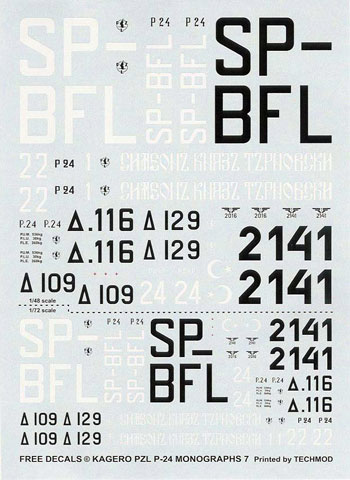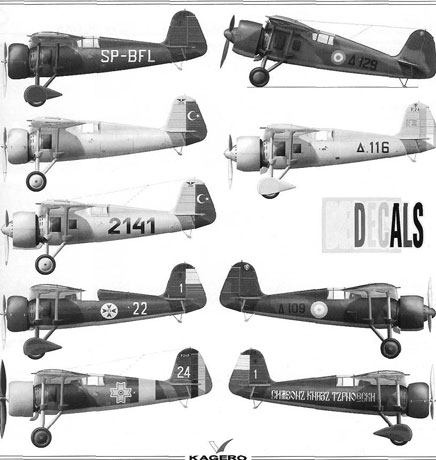|
S u m m a r y
|
| ISBN: |
83-89088-33-9 |
| Media: |
Soft cover, 80 pages of text and
pictures. 11 pages of profiles. |
| Price: |
USD$22.47 from Squadron Mail Order |
| Review Type: |
First Read |
| Advantages: |
Polish and English text. Decals
in 1/72 and 1/48 for nine aircraft and masks for clear parts;
excellent and extensive pictures and drawings. |
| Disadvantages: |
|
| Recommendation: |
Highly Recommended |
Reviewed by
Steven "Modeldad" Eisenman

Kagero's
PZL P.24A-G is available online from Squadron.com
 According
to the author, the PZL P.24 was, for a period during the 1930’s, one of
the fastest and most heavily armed fighters in the world. But the Polish
Air Force never put it into service. It also incorporated the unique
gull wing created by Zygmunt Pulawski the main designer for PZL (Panstwowe
Zaklady Lotnicze or National Aircraft Works) , and which became know as
the “Pulawski Wings” or “Polish Wings”. According
to the author, the PZL P.24 was, for a period during the 1930’s, one of
the fastest and most heavily armed fighters in the world. But the Polish
Air Force never put it into service. It also incorporated the unique
gull wing created by Zygmunt Pulawski the main designer for PZL (Panstwowe
Zaklady Lotnicze or National Aircraft Works) , and which became know as
the “Pulawski Wings” or “Polish Wings”.
The monograph begins with the history of the development of the P.24.
We discover that the P.24 became heavily armed because the 14 cylinder
rotary engine hade no space through which fuselage mounted machine guns
could be placed. I presume that since they had to mount the weapons on
the wings, they said to themselves; “why not go for the big 20 mm
Oerlikon cannon”, which is what they did, although not all models used
the cannon.
The monograph then describes the use of the PZL P.24 with the air forces
of various nations: The P.24 A and C with Turkey; the P.24B with
Bulgaria; the P.24E with Rumania and the P. 24F and G with Greece. There
are numerous and excellent pictures to illustrate the P.24s in the
service of each nation’s air force.
The text of the monograph goes on to provide a full technical
description of the P.24. It intricately describes the wings, fuselage,
control surfaces cockpit, engines and armament. The text concludes with
a description of the various paint schemes that were applied to the P.24
by and for each of the countries that used this aircraft.
This monograph provides not only an excellent written description of the
PZL P.24, but also provides an abundance of excellent pictures, diagrams
and drawings showing nearly every aspect of this aircraft. Each model of
the P.24 is described, such that you can quickly discern the differences
between an E and an F or a B and a C. There is even a page showing the
variety of letters, numbers and logos applied by the various users. The
profiles are numerous and well done.

Finally Kagero provides the icing on the cake in the form of a set of
decals, printed by TECHMOD, and masks. The decals are in both 1/72 and
1/48 scale. Presumably the masks are to be used on the Mirage 1/48 P.24
kits. There are marking for nine aircraft, but there are no national
symbols. These would be included in the model kit or obtained elsewhere.
For each of the aircraft on the sheet, there is a full color profile.
The English text is a full translation of the Polish, and is in
parallel columns. The translation appears well done with only minor
lapses.
If you are going to build the Mirage PZL P.24s or have any interest in
the less well known aircraft of WW-2, then this is a great volume to
get.
Highly Recommended
Thanks to Squadron
for the review sample
Review Copyright © 2004 by
Steven "Modeldad" Eisenman
This Page Created on 15July, 2004
Last updated 14 July, 2004
Back to HyperScale Main Page
Back to Reviews Page
|
Home | What's
New | Features
| Gallery |
Reviews | Reference
| Forum
| Search